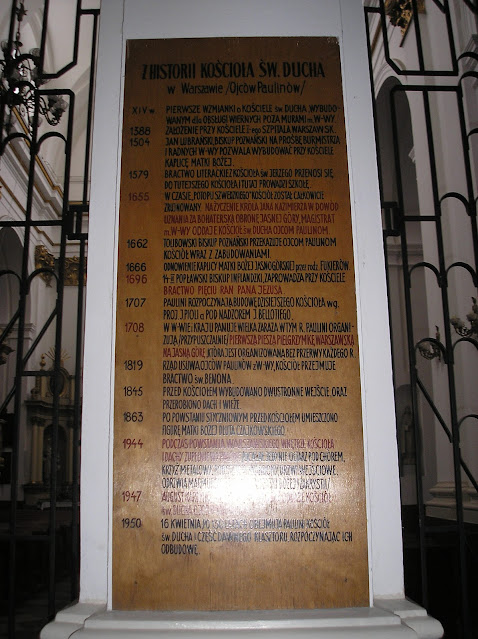W 1708 r. w Warszawie panuje wielka zaraza. W tym roku paulini organizują pierwszą Pieszą Pielgrzymkę Warszawską na Jasną Górę, aby uprosić u Matki Bożej oddalenie zarazy.
Po ustaniu zarazy, z kościoła św. Ducha wyrusza piesza pielgrzymka na Jasną Górę, z dziękczynnym wotum Warszawy dla Matki Najświętszej. Od 1711 r. datuje się ciągłość Pieszej Pielgrzymki Warszawskiej prowadzonej do dnia dzisiejszego przez paulinów.
W 1819 r. rząd carski usuwa ojców paulinów z Warszawy, a kościół przejmuje niemieckie bractwo św. Benona. Po Powstaniu Styczniowym przed kościołem umieszczono figurę Matki Bożej dłuta Czajkowskiego.
Podczas Powstania Warszawskiego wnętrze kościoła i dachy zostały zupełnie wypalone. Ocalał jedynie ołtarz pod chórem, krzyż metalowy na filarze, podstawa skarbony, drzwi wejściowe, odrzwia marmurowe do kaplicy Matki Bożej i zakrystii.
W 1950 roku, po 130 latach, obejmują paulini kościół św. Ducha i część dawnego klasztoru, rozpoczynając ich odbudowę.
The first mention of the Church of the Holy Spirit outside the walls of the city of Warsaw dates back to the 14th century. During the Swedish Deluge, the church was completely ruined. At the request of King John Casimir, in recognition of the heroic defense of Jasna Góra, the City of Warsaw handed over the church of St. Spirit to the Pauline Fathers. In 1707, the Pauline Fathers began the construction of a Baroque church designed by Józef Piola under the supervision of J. Belloti.
In 1708, there is a great plague in Warsaw. This year, the Pauline monks are organizing the first Warsaw Walking Pilgrimage to Jasna Góra to ask the Mother of God to remove the plague.
After the end of the plague, from the church of St. Spirit, a walking pilgrimage to Jasna Góra sets off with Warsaw's thanksgiving votive offering to the Holy Mother. From 1711, the continuity of the Walking Warsaw Pilgrimage, led by the Pauline Fathers, dates back to 1711. In 1819, the tsarist government removes the Pauline Fathers from Warsaw, and the church takes over the German brotherhood of St. Benon. After the January Uprising, a figure of Our Lady by Tchaikovsky was placed in front of the church. During the Warsaw Uprising, the interior of the church and the roofs were completely burnt out. Only the altar under the choir, a metal cross on a pillar, the base of the treasury, the entrance door, and the marble doors to the chapel of Our Lady and the sacristy survived.
In 1950, after 130 years, the Pauline Fathers took over the church of St. Spirit and part of the former monastery, starting their reconstruction.
Die erste Erwähnung der Heilig-Geist-Kirche außerhalb der Stadtmauern von Warschau stammt aus dem 14. Jahrhundert. Während der schwedischen Sintflut wurde die Kirche vollständig zerstört. Auf Wunsch von König Johann Kasimir übergab die Stadt Warschau in Anerkennung der heldenhaften Verteidigung von Jasna Góra die Kirche St. Geist den Paulinervätern. 1707 begannen die Pauliner mit dem Bau einer Barockkirche nach einem Entwurf von Józef Piola unter der Leitung von J. Belloti.
1708 gibt es in Warschau eine große Pest. In diesem Jahr organisieren die Paulinermönche die erste Warschauer Wanderpilgerfahrt nach Jasna Góra, um die Gottesmutter zu bitten, die Pest zu beseitigen.
Nach dem Ende der Pest, von der Kirche St. Geist, eine Wanderwallfahrt nach Jasna Góra, beginnt mit Warschaus Danksagung an die Heilige Mutter. Ab 1711 geht die Kontinuität der Wallfahrt zu Fuß durch Warschau, die von den Paulinerpatern geleitet wird, auf das Jahr 1711 zurück. 1819 entfernt die zaristische Regierung die Pauliner aus Warschau und die Kirche übernimmt die deutsche Bruderschaft St. Benon. Nach dem Januaraufstand wurde vor der Kirche eine Figur der Muttergottes von Tschaikowsky aufgestellt. Während des Warschauer Aufstands brannten das Innere der Kirche und die Dächer vollständig aus. Nur der Altar unter dem Chor, ein Metallkreuz auf einer Säule, der Sockel der Schatzkammer, die Eingangstür und die Marmortüren zur Kapelle Unserer Lieben Frau und zur Sakristei blieben erhalten.
1950, nach 130 Jahren, übernahmen die Pauliner die Kirche St. Geist und ein Teil des ehemaligen Klosters beginnen mit dem Wiederaufbau.




Brak komentarzy:
Prześlij komentarz